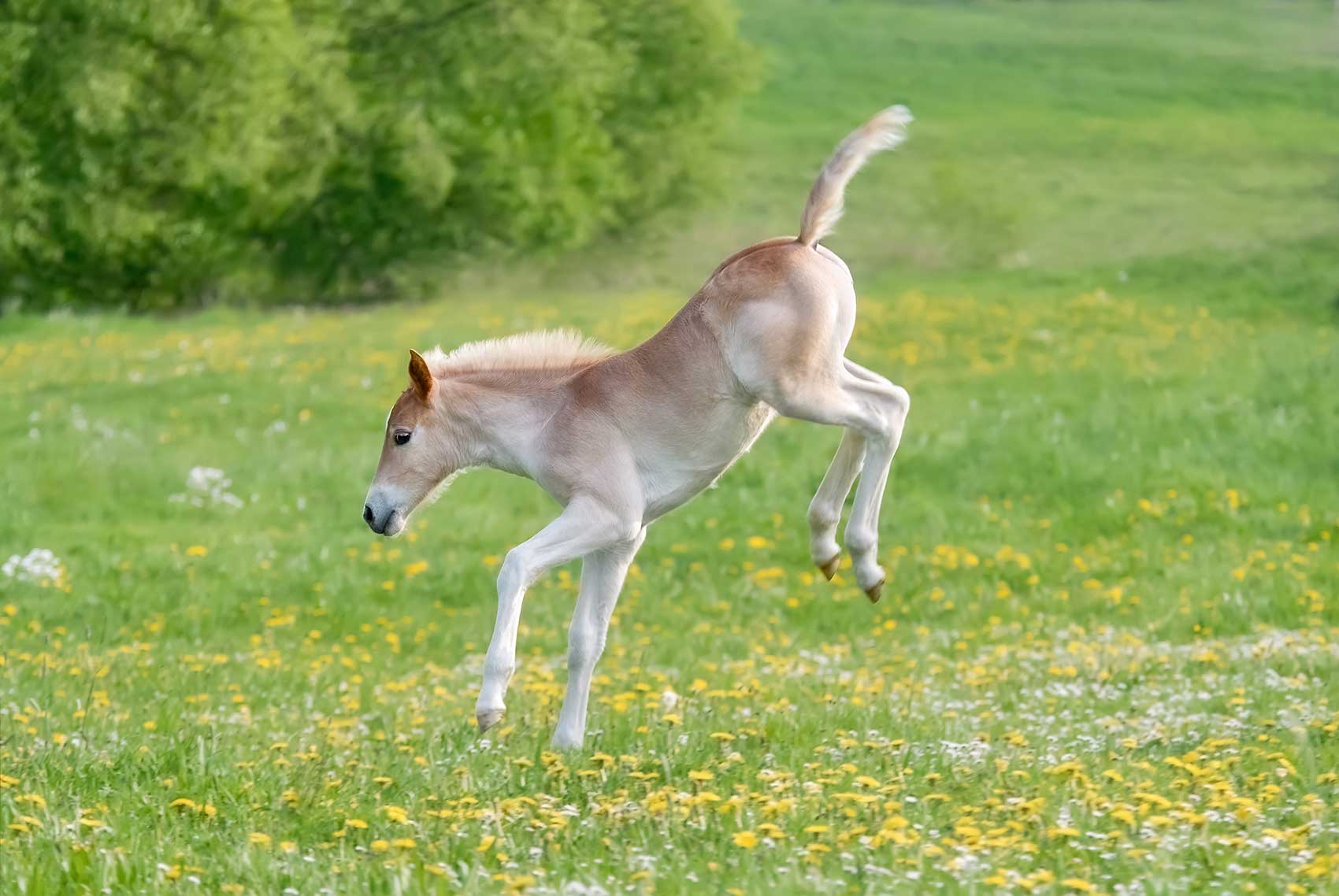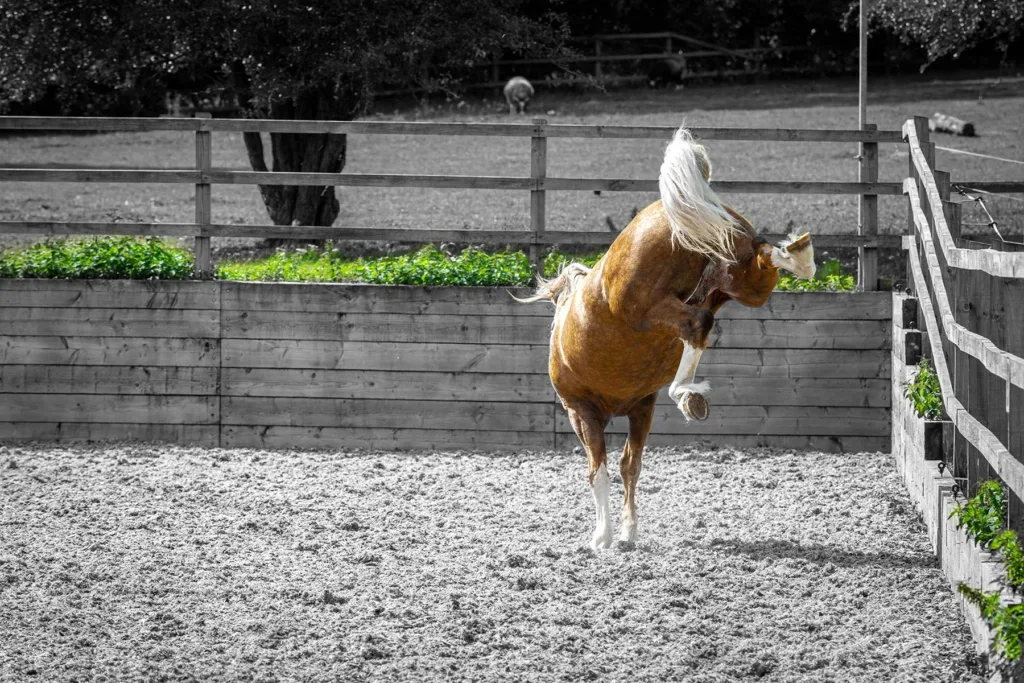Is it excitement? Is it discomfort? Or is your pony trying to tell you something? Let’s find out!
We’ve all seen it—or maybe even felt it! A pony suddenly kicks up their back legs, sometimes giving a little jump, sometimes a big bounce. This behaviour is called bucking, and while it might look dramatic, it’s one of the ways ponies communicate.
Let’s explore why ponies buck and what they might be trying to say.
First of all: What is a buck?
Bucking is when a pony lowers their head and lifts or kicks their back legs into the air. It’s a totally natural movement that ponies also use when playing with their friends or letting off steam in the paddock.
So while it might feel surprising in the saddle, it doesn’t automatically mean anything is wrong.
Sometimes bucking means your pony feels full of energy!
Ponies, just like people, can get excited, especially when they’ve had a rest day, the weather is cooler, or they’re feeling fresh.
A quick buck during a canter or after a jump might simply mean:
“I’m feeling great today!”
This type of bucking is playful and usually short-lived. If your pony tends to feel fresh, it can help to give them a lunge before riding, especially after a few days off.
Sometimes, though, bucking can mean discomfort or pain
Even though it might be nothing to worry about, it’s still really important to know that bucking can be a sign your pony is uncomfortable somewhere in their body.
Ponies might buck if:
- Their back is sore
- Their saddle doesn’t fit properly
- They’re feeling stiff or tight in their muscles
- They have ulcers or sore teeth
- Something hurts when they move in a certain way
If your pony suddenly starts bucking, especially in canter or after a new activity, it’s a good idea to chat with your instructor and possibly your vet or physio. Tack checks and a general health check can make a big difference.
Sometimes ponies buck when they’re confused
Imagine if someone asked you to do something you didn’t understand—how would you feel?
Ponies sometimes buck if they’re unsure what’s being asked or feel overwhelmed. This can happen when:
- They’re learning something new
- The rider’s signals are unclear or too strong
- They’re feeling tense or worried
If your pony seems anxious, slowing things down, going back to basics, and staying calm can help. Kind, clear riding builds confidence—for both of you!
Can ponies buck out of habit?
Some ponies learn to buck in certain situations—for example, when asked to canter or go over a jump—because they’re used to doing it. This doesn’t mean they’re being badly behaved, just that they’ve made an association with that movement.
It’s not their fault—they’re just repeating what they’ve learned. The best way to help is to stay calm, work with an instructor, and help your pony feel strong, balanced, and relaxed.
How can I tell what my pony’s buck means?
Here’s a quick guide:
| Why they might buck | What you might notice |
| Feeling fresh | Ears forward, happy expression, happens during fun activities |
| Discomfort or pain | Ears back, tail swishing, stiff movement, sudden behaviour |
| Feeling confused | Hesitation, tension, unsure body language |
| Habit or association | Bucking in similar situations every time |
What to do if your pony bucks
- Stay calm and balanced.
- Check their body and tack. Ask a grown-up or your coach to help.
- Be kind and clear. Use gentle, steady signals and lots of praise.
- Work with a pro. Your riding instructor, vet, or physio can help figure out what’s going on.
- Don’t panic! Most ponies can learn to feel confident and happy again.
Final thoughts
Bucking might feel scary, but it’s one of the few ways a pony can show how they feel. Whether they’re saying “I’m full of beans!” or “Something feels wrong,” it’s up to us to listen kindly and help them feel safe, strong, and understood.
Ponies don’t buck because they’re being mean. They buck because they’re trying to tell us something. And once we learn to listen, we become even better pony partners.

QUIZ: Why did my pony buck?
Circle the answers that feel true for your ride today!
1. What was the weather like today?
A. Cold and windy – my pony hadn’t been out much
B. Normal weather – nothing strange
C. Hot and stuffy – he seemed grumpy before I even got on
2. How long has it been since your pony was last ridden?
A. A few days – he was very fresh!
B. We’ve been riding regularly
C. I’m not sure, but he’s been in a small paddock or stable
3. When did your pony buck?
A. During a canter or gallop—he felt super excited
B. When I asked something new or tricky
C. When I did something we’ve done lots of times before
4. What was your pony’s body language like?
A. Ears up, felt bouncy but happy
B. A bit tense—maybe confused
C. Ears back, swishing tail, didn’t want to go forward
5. How often does this happen?
A. Hardly ever—just when he’s feeling fresh
B. Sometimes—especially in certain lessons or movements
C. It’s starting to happen more often and in the same spots
Now let’s check your answers!
Mostly A’s – Your pony might be feeling fresh!
It sounds like your pony had lots of energy and needed to let it out. This kind of buck is usually playful, but make sure they get a good warm-up or lunge first next time.
Mostly B’s – Your pony might be unsure or confused
Your pony might not fully understand what’s being asked. Try using clear, gentle aids, and don’t be afraid to go back a step. Everyone learns at their own pace!
Mostly C’s – Your pony might be uncomfortable
If bucking is becoming regular or happens during normal things, your pony could be feeling sore or unhappy in their body. Ask your instructor or parent to check saddle fit and talk to your vet or physio.
Remember: Bucking is your pony’s way of talking. If we listen kindly and work as a team, we can help them feel their best.



